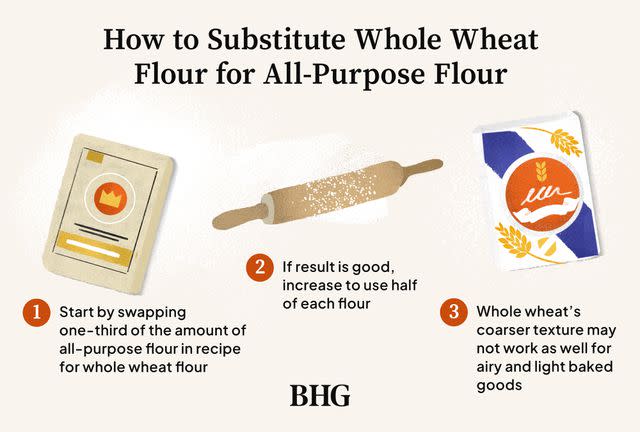How to Substitute Whole Wheat Flour for All-Purpose Flour
Learn how to swap whole wheat flour for all-purpose flour (yes, you can do it!) with these must-know secrets from our Test Kitchen.
Fact checked by Emily Estep
If you're keeping an eye on nutrition, you may want to substitute whole wheat flour for all-purpose flour to add more whole grains to your diet. Congratulations! You are indeed making a healthier choice when using a whole wheat flour substitute in place of the more common all-purpose flour. But take note, if a recipe calls for one cup of all-purpose flour and you swap that for one cup of whole wheat flour, you'll likely get a not-so-tasty result. We'll explain why and help you reduce some of the all-purpose flour in your recipes and increase whole wheat flour.
Related: 11 Types of Flour Every Home Cook Should Know and How to Use Them

BHG / Michela Buttignol
How to Substitute Whole Wheat Flour for All-Purpose Flour
You can replace some but not all of the all-purpose flour with whole wheat flour when baking. Swapping equal amounts results in baked goods that are too dense with an off-putting flavor. Blending whole wheat flour with all-purpose flour will lighten the finished product while adding the nutritional benefits of whole wheat. Try it the next time you make breading for a chicken breast recipe, or thicken a sauce. Just remember the flavor could vary.
When baking, experiment with your ratio of whole wheat to all-purpose. Start by swapping one-third of the amount of flour in your recipe for whole wheat (if your recipe calls for one cup flour, use ⅓ cup whole wheat and ⅔ cup all-purpose). If that result is good, increase to use half all-purpose flour and half whole wheat flour.
Because whole wheat flour is ground from the entire wheat kernel to retain more nutrients and fiber, it also has a coarser texture, which doesn't work as well when you're trying to bake something airy and light.
Related: Whole Wheat Hamburger Buns

How to Use White Whole Wheat Flour
Increasingly common in grocery stores is white whole wheat flour. Nutritionally, it's the same as whole wheat flour. White whole wheat flour is still made from the entire kernel (aka a whole grain); the plant is simply lighter in color and flavor. In baking, you may be able to substitute higher ratios of white whole wheat flour to all-purpose flour than regular whole wheat flour before you notice flavor differences. This is a good one to have in your arsenal as a healthy flour substitute.
Related: Whole Wheat Pumpkin Bread
Whole Wheat Flour vs All-Purpose Flour Nutrition
You know whole wheat flour is a whole grain, but how do the nutrients really stack up? Here's how they sift out on a cup-by-cup comparison.
In one cup all-purpose flour: 13 grams protein, 95 grams carbohydrate, three grams fiber, one gram of fat.
In one cup whole wheat flour (or white whole wheat flour): 16 grams protein, 86 grams carbohydrate, 13 grams fiber, three grams fat.
Whether you need an emergency substitution or are just trying to make healthier food choices, you can handle using whole wheat flour in place of all-purpose.
Related: Whole Wheat Chocolate-Blueberry Cake
For more Better Homes & Gardens news, make sure to sign up for our newsletter!
Read the original article on Better Homes & Gardens.

